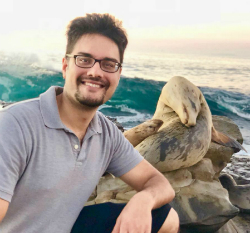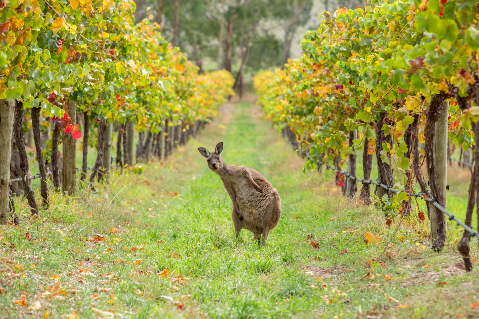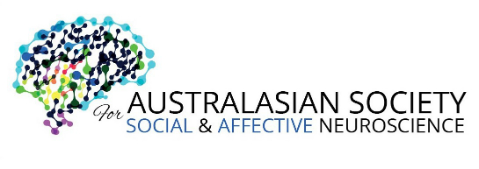|
In This Issue...
- Be Your Own Advocate
- The Year of the Woman in Science: What does it take to be successful in science?
- Trending Science
- IBNS Impact Story: From an IBNS meeting to a new research field
- United we stand, divided science falls: Love thy peer as thyself
- Member News
- Feeling depressed? Come see us at IBNS 2019 symposium
- 28th Annual IBNS Conference
- Discount offered for IBNS members at the official IBNS Satellite AS4SAN Conference
- Pre- and Post-IBNS Conference Tours
Be your own advocate
Firyal Ramzan, M.A. Psychology
Graduate Student, PhD Candidate
University of Toronto, Mississauaga, ON, Canada
 Studying neuroscience has been one of the most captivating experiences of my life. Through pursuing graduate studies, I have encountered numerous opportunities that have helped me along the way. Studying neuroscience has been one of the most captivating experiences of my life. Through pursuing graduate studies, I have encountered numerous opportunities that have helped me along the way.
I remember attending a Career Development workshop at IBNS 2016 in Hungary. It was during this session that one of the professors told us, the trainees, about the importance of advocating for ourselves. Whenever any opportunity comes up, such as scholarship or grant applications, always apply for it. One of the biggest issues that graduate students deal with in academia is imposter syndrome. It is important to not let that hold you back. You never know when you will win something. It was mind-opening for me, at the time a relatively new graduate student, because I had not yet realized the importance of self-advocacy.
Ever since, I made sure to apply for any opportunities that I came across. One example that is particularly prominent in my mind is when I won the SfN Professional Development Travel Award in 2017. I thought I was not at all competitive enough to win. However, as soon as I heard of it, I applied. I ended up winning the award, despite having an ordinary CV. It was also the one award I won while having applied to several different awards, which I did not end up winning. This goes to show that you should never let yourself be limited by perception.
In the same vein, I applied to present an oral talk at almost every conference I attended since. I really believe that it is very important to advocate for your research because no one else is going to do it for you. Last year I, was selected to present at a nanosymposium session at SfN. This was a session of about 10 minutes where neuroscientists from around the world attend your talk. It was a truly amazing experience to be able to present my research to fellow researchers and have conversations about it after. I was also able to work on my presentation skills through the process of developing and practicing my talk. So, not only was I able to put my research out there, but there was the bonus of improving a very important skill.
I am now in my final year of graduate school and, without a doubt, one of the most important things I’ve learned is to advocate for yourself and your research. Also, do not ever hesitate to apply to any opportunities that come your way.
Back to Top
The Year of the Woman in Science: What does is take to be successful in science?
An Interview with Dr. Ewelina Knapska
Dr. Kesnia Meyza, PhD, Guest Editor
Laboratory of Emotions' Neurobiology
Nencki Institute of Experimental Biology
Polish Academy of Sciences, Warsaw, Poland
"What does it take to be successful in science?," I asked Dr. Ewelina Knapska, the head of the Laboratory of Emotions’ Neurobiology at the Nencki Institute of Experimental Biology in Warsaw, Poland. In recent years, she has been a PI in a European Research Council Starting Grant, Polish-Swiss Research Grant, several grants from the Polish National Science Centre, COST Action BM0901, and a Homing Grant of Foundation for Polish Science. She is a member of FENS-Kavli network, the Dana Alliance for Brain Initiatives (DABI), AcademiaNet, ENINET and the European Brain and Behavior Society committee. In 2012 she started her own group in which she studies neuronal mechanisms of social transfer of emotions [1-4]. She is also interested in developing ecologically relevant ways of testing social behavior in rodents [5-6].
KM: What, according to you, makes a scientist successful? 
EK: In basic science, it is quite simple. We try to discover facts, relations and dependencies between facts, processes and mechanisms. When we are lucky and well prepared, we can sometimes nail it and show that one relevant bit of knowledge to the (scientific) world. When we make a compelling case, our colleagues sometimes pause to watch. If we are very lucky, we make them think differently about world. And this is what I would call a success in science.
KM: To what extent is success based on the dedication and hard work of the scientist and how much of it is dependent on the environment in which she or he develops their career?
EK: Having only one life to live, it is difficult to design a controlled first-person experiment about it. I am very fortunate to have had a very supportive and stimulating environment throughout my career. I have always worked hard to contribute meaningfully to my community and this gradually allowed me to make intellectually valuable connections and to have many inspiring interactions. In this sense, the two things are not independent and a scientist should actually choose and shape his or her environment.
KM: Does gender matter when you are at an early stage of your scientific career in times when women take to the streets (women’s march, women’s wall, czarny protest) to protect their rights?
EK: This is a tricky question. I am inclined to say no, because I cannot recall many situations from my early career in which my gender played a role. But I was always surrounded by people who not only inspired and supported me, but behaved professionally, which let me stay focused on my projects and not think in terms of my gender. With time, I have realized that my experience is not necessarily representative of all women in science, so I am trying to offer my young female colleagues the same opportunities of professional growth that I received. You might say that, in this way, I am trying to pay back for the good treatment I received.
KM: How does one balance being a scientist and a mother of two?
EK: I don’t have to. I just tell my partner what to do about the kids and the household. And if you think that I am joking, you are wrong – I have seen too many women scientists consumed not by new research ideas, but by the weight of responsibility of caring for their young children with little or no real support from their partners, families and the state. That is why I believe that sharing tasks around the house helps both partners stay focused on work, while enjoying the fulfillment of family life.
KM: What is your one piece of advice for young women in science?
EK: Live like there is no tomorrow, but plan your actions to achieve five-year goals. Think big, reach far and do not despair if you hit a rough patch in your research. And do not spend too much time trying to get rid of your weaknesses, but rather try to nurture your strengths.
KM: And what is your one piece of advice for young men in science?
EK: Never underestimate women.
Photo of Dr. Kanoska courtesy of OneHD and the Foundation for Polish Science
1: E. Knapska E, et al. Between-subject transfer of emotional information evokes specific pattern of amygdala activation. Proc Natl Acad Sci U S A. 2006 Mar 7;103(10):3858-62. Epub 2006 Feb 23. PubMed PMID: 16497832; PubMed Central PMCID: PMC1533786.
2: K. Meyza et al. The roots of empathy: Through the lens of rodent models. Neurosci Biobehav Rev. 2017 May;76(Pt B):216-234. doi: 10.1016/j.neubiorev.2016.10.028. Epub 2016 Nov 4. Review. PubMed PMID: 27825924; PubMed Central PMCID: PMC5418107.
3: Nowak A, Werka T, Knapska E. Social modulation in extinction of aversive memories. Behav Brain Res. 2013 Feb 1;238:200-5. doi: 10.1016/j.bbr.2012.10.031. Epub 2012 Oct 26. PubMed PMID: 23103405.
4: K. Meyza et al. Neuronal correlates of asocial behavior in a BTBR T (+) Itpr3(tf)/J mouse model of autism. Front Behav Neurosci. 2015 Aug 6;9:199. doi: 10.3389/fnbeh.2015.00199. eCollection 2015. PubMed PMID: 26300749; PubMed Central PMCID: PMC4526814.
5: A. Puścian et al. Eco-HAB as a fully automated and ecologically relevant assessment of social impairments in mouse models of autism. Elife. 2016 Oct 12;5. pii: e19532. doi: 10.7554/eLife.19532. PubMed PMID: 27731798; PubMed Central PMCID: PMC5092044.
6: K. Kondrakiewicz et al. Ecological validity of social interaction tests in rats and mice. Genes Brain Behav. 2018 Oct 11:e12525.doi: 10.1111/gbb.12525. [Epub ahead of print] Review. PubMed PMID: 30311398.
Back to Top
February Newsletter vol 23-2 Guest Editors:

Sreeparna Majumdar
Stark Neurosciences Research Institute, Indiana University School of Medicine
Indianapolis, Indiana, USA

Ksenia Meyza
Laboratory of Emotions' Neurobiology
Nencki Institute of Experimental Biology, Polish Academy of Sciences
Warsaw, Poland
Thank you, Sreeparna and Ksenia!
Acknowledgement: The Guest-Editors are pleased to acknowledge the generous support, information resources and technical inputs received from Jennifer C Parada (Swedish Neuroscience Institute, Seattle, Washington, USA).
Interested in serving as a Guest Editor for the IBNS News?
Email: [email protected]
Looking for a New Employment Opportunity or Struggling to Find the Right Candidate? Meet the IBNS Career Center!
One of the biggest challenges for any international scientific society is to provide quality and informative support to its members, whether it's for a new employment opportunity or finding the right candidate for a newly opened position. The IBNS online Career Center portal (http://jobs.ibnsconnect.org) provides the right tools for both job seekers and employers.

The IBNS Career Center portal offers all the standard operational features; such as a thorough search engine by keyword and location, as well as a free review of your resume for feedback, and a job-posting service for employers. However, what makes the IBNS Career Center stand out in terms of support is two additional quality features: resources for job seekers & access to a resume bank for employers.

In the Resources section, you have access to a number of articles with valuable tips in building a resume, job seeking, and communication. These tips come from experienced scientists in the field -- not only for searching or applying for a position, but also for the interview process. Interested in 'building your brand’ or strengthening your social media presence? You will find plenty of advice and tips to do so, which will help strengthen your image and move your career to the direction you want!
In the Resume Bank, potential employers have free access to a large bank of resumes and profiles. You can customize the filters that apply to your search and create lists of candidates that fulfill your own criteria.
Back to Top
Trending Science
In this column, we share the latest research, interesting scientific articles and news.
Sreeparna Majumdar, Guest Editor
Stark Neurosciences Research Institute, Indiana University School of Medicine
Indianapolis, Indiana, USA
We are delighted to present three excellent research papers generated by our senior IBNS members...
- Vitamin C in treatment of breast cancer
- How does Cannabis use in adolescence impair memory?
- Do humans cry like rats do?
Chronic stress increases lactate dehydrogenase A (LDH A) and promotes breast cancer stem cells: Vitamin C might be an effective therapeutic strategy
Dr. Quentin Liu
Dalian Medical University & Sun Yat-sen University, China
and Dr. Keith W. Kelley
University of Illinois at Urbana-Champaign, Illinois, USA

Published in January 2019 edition of the Journal of Clinical Investigation, leading and corresponding author Dr. Quentin Liu along with Dr. Keith W. Kelly presented an intriguing research on the putative therapeutic role of vitamin C against stress-induced breast cancer [1].
Breast cancer is the leading cause of death in women suffering from cancer, globally. Cancer patients often experience chronic emotional stress, fear and mental health problems such as depression and anxiety. These associated problems exacerbate patient’s condition by accelerating tumor growth and modulating expression profile of invasion-related genes, which leads to progression of the disease.
The study by Cui et al., found that epinephrine, stress-induced hormone triggers biochemical pathways that promote breast cancer progression [1]. Chronic stress has long been associated with sustained activation of hypothalamic-pituitary-adrenal (HPA) axis resulting in increased cortisol production and concurrent increases in catecholamines [2]. In this study, researchers showed, for the first time, that chronic stress promotes growth of breast cancer stem cells. Establishing this link between chronic stress and breast cancer stem cell progression is a novel discovery.
Researchers employed a chronic stress model where mice were placed in a small confined space, which restricted free movement. Both control and the stressed group were subjected to this protocol for a week, after which they either inoculated with human or mouse breast cancer cells. Mice in stressed group stayed back in the small space whereas the control group was moved to large cages, for a month. Group subjected to chronic stress exhibited anxiety- and depression-like behaviors, larger and faster-growing tumors with more cancer stem cells than the control group.
Stress can modulate tumor growth and promote cancer via neuroendocrine regulation of immune response to tumor cells. Tumors constitute of various kinds of cancer cells that contribute to tumor heterogeneity, among which cancer stem cells (CSC) play a vital role in cancer initiation, maintenance and progression. CSC’s are characterized by their self-renewability and ability to differentiate. Tumor progression has positive correlation with Lactate dehydrogenase A (LDHA) and high lactate levels. LDHA-associated lactic acid generation results in relatively low pH in the tumor microenvironment, which allows cancer cell survival [3, 4].
Serum levels of epinephrine were significantly higher in the stressed group and epinephrine  increased the expression levels of stem cell markers. Pharmacological blocking of β2 adrenergic receptor resulted in smaller tumors. increased the expression levels of stem cell markers. Pharmacological blocking of β2 adrenergic receptor resulted in smaller tumors.
Collectively, the researchers provide evidence that chronic stress induced epinephrine acts on β2 adrenergic receptors to promote breast cancer stem cell progression through increase in LDHA-generated lactate levels. Vitamin C treatment could suppress stress induced LDHA activity, alters lactate production. Additionally, vitamin C inhibits tumor growth and progression caused due to chronic stress.
Vitamin C promotes cell death and apoptosis in different cancer types [5-7]. Taken together, the study identifies vitamin C as a strong candidate for effective therapeutic intervention in breast cancer patients experiencing chronic stress.
1. Cui, B., et al. (2019). Stress-induced epinephrine enhances lactate dehydrogenase A and promotes breast cancer stem-like cells. J Clin Invest, pii: 121685. doi:10.1172/JCI121685
2. Powell, N. D., Tarr, A.J., & Sheridan, J. F. (2013). Psychosocial stress and inflammation in cancer. Brain Behav Immun, 30 Suppl, S41-47.
3. Brand, A., et al. (2016). LDHA-Associated Lactic Acid Production Blunts Tumor Immunosurveillance by T and NK Cells. Cell Metab, 24, 657-671.
4. Choi, S. Y., Collins, C.C., Gout, P.W., & Wang, Y. (2013). Cancer-generated lactic acid: a regulatory, immunosuppressive metabolite? J Pathol, 230, 350-355.
5. Polireddy, K., et al. (2017). High Dose Parenteral Ascorbate Inhibited Pancreatic Cancer Growth and Metastasis: Mechanisms and a Phase I/IIa study. Sci Rep 7, 17188.
6. Gustafson, C. B., et al. (2015). Epigenetic reprogramming of melanoma cells by vitamin C treatment. Clin Epigenetics 7, 51.
7. Liu, M., et al. (2016). Vitamin C increases viral mimicry induced by 5-aza-2'-deoxycytidine. Proc Natl Acad Sci U S A 113, 10238-10244.
Back to Top
Back to Trending Science Topics
How does smoking weed in adolescence impair memory? Cannabis vulnerability can be largely mediated by astrocytes via convergent inflammatory signaling
Dr. Mikhail Pletnikov, MD, PhD, IBNS Treasurer and Past-President
Johns Hopkins University School of Medicine
Baltimore, MD, USA
 Cannabis, also commonly known as weed or marijuana, is the most widely used illicit drug of abuse in the United States and worldwide. Cannabis use has been associated with various mental health issues, especially among the youth. Although acute impairment of cognitive capacity has been well established the chronic effect of cannabis exposure is not well understood. Not all cannabis users develop cognitive impairment, indicating genetic vulnerability to adverse effects of cannabis. The underlying mechanism by which cannabis induces chronic behavioral and cognitive abnormalities is unknown. Cannabis, also commonly known as weed or marijuana, is the most widely used illicit drug of abuse in the United States and worldwide. Cannabis use has been associated with various mental health issues, especially among the youth. Although acute impairment of cognitive capacity has been well established the chronic effect of cannabis exposure is not well understood. Not all cannabis users develop cognitive impairment, indicating genetic vulnerability to adverse effects of cannabis. The underlying mechanism by which cannabis induces chronic behavioral and cognitive abnormalities is unknown.
A novel study recently published in Biological Psychiatry by a research group at John Hopkins University, led by Mikhail "Misha" Pletnikov, describes biological evidences in animal models suggesting that cannabis use in youth may interact with an underlying genetic predisposition to cause cognitive impairments later in life in some users [1].
Animal research provides evidence that supports the possibility that adolescent brains could have a period of heightened vulnerability to cannabis exposure [2]. There is evidence demonstrating persistent deficits in object recognition tasks in pubertal rats receiving cannabinoid agonist treatment [3, 4]. Additionally, cognitive effects of exogenous cannabinoids have been associated with adverse effects on hippocampal neuronal circuits. Hippocampus plays a vital role in spatial recognition memory, which is important in the context of this study.
In the current study, Jouroukhin et al., employs an animal model of inducible expression of dominant-negative (DN) form of disrupted in schizophrenia 1 (DISC1) selectively in hippocampal astrocytes to determine the molecular basis how astrocyte genetic vulnerability could interact with environment (i.e. adolescent Δ9-THC exposure) to disrupt recognition memory in adulthood [1].
The animal model utilizes a rare and highly penetrant mutation of a DISC1, a gene disrupted in a t(1;11) (q42.1;q14.3) translocation that segregated in a Scottish family having several major psychiatric disorders. The rationale behind employing this model was based on evidences that suggested its contribution to behavioral and cognitive abnormalities and having role in mechanistic studies [5, 6].
The study demonstrates for the first time that a synergistic interplay between genetic predisposition and adolescent Δ9-THC exposure could produce a sustained activation of nuclear factor (NF)-κB--cyclooxygenase(COX)-2 signaling in astrocytes.
Δ9-THC is a partial agonist of brain cannabinoid receptor (CNR1), which is expressed in both neurons and glial cells. In the current study, researches demonstrate that knock down (KD) of endogenous DISC1 in hippocampal astrocytes but not neurons, synergistically interact with adolescent Δ9-THC exposure. This then activates NF-κB--COX-2 signaling pathway in astrocytes leading to increased glutamate secretion and decreased immunoreactivity of parvalbumin–positive presynaptic inhibitory boutons surrounding the pyramidal neurons of the hippocampal CA3 area. Data from the present study showed that COX2 inhibitor administration prevented the cognitive abnormalities.
Earlier research works provide evidence that astrocyte CNR1, NF-κB signaling and increase in COX-2 play a role in cognitive impairments due to Δ9-THC exposure in rodents [7-9]. This effect could potentially lead to excessive glutamate release by astrocytes.
In conclusion, the current study provides evidence for synergistic interaction between genetic predisposition and adolescent Δ9-THC exposure that leads to sustained activation of inflammatory signaling pathway in astrocytes, which could be potential targets for preventing adverse effects of cannabis within susceptible subjects.
The study demonstrates for the first time that a synergistic interplay between genetic predisposition and adolescent Δ9-THC exposure could produce a sustained activation of nuclear factor (NF)-κB--cyclooxygenase(COX)-2 signaling in astrocytes.
Δ9-THC is a partial agonist of brain cannabinoid receptor (CNR1), which is expressed in both neurons and glial cells. In the current study, researches demonstrate that knock down (KD) of endogenous DISC1 in hippocampal astrocytes but not neurons, synergistically interact with adolescent Δ9-THC exposure. This then activates NF-κB--COX-2 signaling pathway in astrocytes leading to increased glutamate secretion and decreased immunoreactivity of parvalbumin–positive presynaptic inhibitory boutons surrounding the pyramidal neurons of the hippocampal CA3 area. Data from the present study showed that COX2 inhibitor administration prevented the cognitive abnormalities.
Earlier research works provide evidence that astrocyte CNR1, NF-κB signaling and increase in COX-2 play a role in cognitive impairments due to Δ9-THC exposure in rodents [7-9]. This effect could potentially lead to excessive glutamate release by astrocytes.
In conclusion, the current study provides evidence for synergistic interaction between genetic predisposition and adolescent Δ9-THC exposure that leads to sustained activation of inflammatory signaling pathway in astrocytes, which could be potential targets for preventing adverse effects of cannabis within susceptible subjects.
1. Jouroukhin, Y., et al. (2018). Adolescent Δ9-Tetrahydrocannabinol Exposure and Astrocyte-Specific Genetic Vulnerability Converge on Nuclear Factor-κB-Cyclooxygenase-2 Signaling to Impair Memory in Adulthood. Biological psychiatry, pii: S0006-3223(18), 31746-3. doi: 10.1016/j.biopsych.2018.07.024.
2. Lubman, D. I., Cheetham, A., & Yucel, M. (2015). Cannabis and adolescent brain development. Pharmacol Ther 148, 1-16.
3. O'Shea, M., Singh, M. E., McGregor, I. S., & Mallet, P. E. (2004). Chronic cannabinoid exposure produces lasting memory impairment and increased anxiety in adolescent but not adult rats. J Psychopharmacol 18, 502-508.
4. Schneider, M., Schomig, E., & Leweke, F. M. (2008). Acute and chronic cannabinoid treatment differentially affects recognition memory and social behavior in pubertal and adult rats. Addict Biol 13, 345-357.
5. Farrell, M. S. et al. (2015). Evaluating historical candidate genes for schizophrenia. Mol Psychiatry 20, 555-562.
6. Sullivan, P. F., Daly, M. J., & O'Donovan, M. (2012). Genetic architectures of psychiatric disorders: the emerging picture and its implications. Nat Rev Genet 13, 537-551.
7. Han, J., et al. (2012). Acute cannabinoids impair working memory through astroglial CB1 receptor modulation of hippocampal LTD. Cell 148, 1039-1050.
8. Chen, R., et al. (2013). Delta9-THC-caused synaptic and memory impairments are mediated through COX-2 signaling. Cell 155, 1154-1165.
9. Bezzi, P., et al. (1998). Prostaglandins stimulate calcium-dependent glutamate release in astrocytes. Nature 391, 281-285.
Back to Top
Back to Trending Science Topics
Do humans cry like rats do? Are rat ultrasonic vocalizations equivalent to human crying?
Dr. Stefan Brudzynski, PhD, DSc
Brock University
St. Catherines, ON, Canada
There has been an extensive discussion about human crying as a symptom of depression and/or  anxiety for many decades. The biggest difficulty lies in the lack of animal models of adult human crying and lack of full understanding of the biological role of crying across species. Crying is a universal vocalization in human and mammalian infants. While infant crying has been unanimously agreed upon to be a common feature across mammalian species, adult crying has not. Many non-human species of mammals appear not to have overt crying responses in adulthood. The topic of crying in adult mammalian species is rarely investigated. The recent publication by S.M. Brudzynski [1] sheds some light, in a novel way, on the neural mechanisms of crying and its biological role by comparing rats’ aversive vocalizations (22 kHz ultrasonic calls) and human crying, both of which originate from the common aversive emotional arousal. anxiety for many decades. The biggest difficulty lies in the lack of animal models of adult human crying and lack of full understanding of the biological role of crying across species. Crying is a universal vocalization in human and mammalian infants. While infant crying has been unanimously agreed upon to be a common feature across mammalian species, adult crying has not. Many non-human species of mammals appear not to have overt crying responses in adulthood. The topic of crying in adult mammalian species is rarely investigated. The recent publication by S.M. Brudzynski [1] sheds some light, in a novel way, on the neural mechanisms of crying and its biological role by comparing rats’ aversive vocalizations (22 kHz ultrasonic calls) and human crying, both of which originate from the common aversive emotional arousal.
Comparison of such distant species as rats and humans is important because it illustrates the common ancestral mammalian mechanisms of vocal expression of aversive arousal in social groups. Detailed comparison of many features and aspects of crying vocalizations led researchers to the conclusion that emission of rat 22 kHz ultrasonic vocalizations represents an evolutionary vocal homolog of adult human crying. However, both these phenomena should not be comprehended in the same fashion because of their primary differences in species-specific cognitive functions. Nevertheless, it is important to note that emission of 22 kHz calls by rats and human crying are homolog vocal expressions of aversive arousal, which in all likelihood, share the same ancestral neural mechanism. This mechanism was extensively studied in rats and it has been shown that the ascending cholinergic pathways, from the brainstem laterodorsal tegmental nucleus to medial diencephalic and forebrain regions as well as most of the limbic structures, contribute to development of aversive emotional arousal. This is one of the sub-systems of the ascending reticular activating system that is not targeted at the cortical mantle and regulation of arousal at the cognitive level but is aimed at subcortical limbic regions. The ascending cholinergic system is responsible for aversive emotional arousal [for more details of this system, see (2)]. This arousal is signalled by emission of vocalization.
It is also worth mentioning that the positive emotional arousal that in humans manifests itself as laughter in social behavior is initiated by an ascending dopaminergic sub-system originating from the ventral tegmental area. The vocal expression of positive emotional arousal is observed in rats as emission of 50 kHz ultrasonic vocalizations, and these calls were suggested to be the evolutionary antecedent of primitive human laughter [3, 4].
In addition, the presented review offers a unique outlook at crying in depressed patients. It is argued that crying is an overt expression of anxiety or an anxiety-like state and is not directly reflecting depression itself but it may be influenced by a depressive mood. The readers might find this publication particularly exciting because this could be useful in research of animal emotional behaviour and human affective behavior and its dysfunctions that should be of interest to most of our members.
1. Brudzynski SM. (2019). Emission of 22 kHz vocalizations in rats as an evolutionary equivalent of human crying: Relationship to depression. Behav. Brain Res., 363: 1-12.
2. Brudzynski SM. (2014). The ascending mesolimbic cholinergic system--a specific division of the reticular activating system involved in the initiation of negative emotional states. J. Mol. Neurosci., 53(3): 436-445.
3. Panksepp J, Burgdorf J. (2003). "Laughing" rats and the evolutionary antecedents of human joy? Physiol. Behav., 79(3): 533-547.
4. Panksepp J, Burgdorf J. (2000). 50-kHz chirping (laughter?) in response to conditioned and unconditioned tickle-induced reward in rats: effects of social housing and genetic variables. Behav. Brain Res., 115(1): 25-38.
Back to Top
Back to Trending Science Topics
IBNS Impact Story: From an IBNS meeting to a new research field
Dr. Ksenia Meyza, Guest Editor
Laboratory of Emotions' Neurobiology
Nencki Institute of Experimental Biology
Polish Academy of Sciences, Warsaw, Poland
This is a story of how powerful bringing like-minded people together can be.
It all started with a call for symposia for the 24th Annual meeting of IBNS, held on June 2-7, 2015 in  Victoria, Canada. Dr. Ewelina Knapska and I decided to discuss our most recent work on emotional contagion and helping behaviors in rodents, and to invite others conducting similar research. So we put forth a proposal for a session entitled “Neuronal correlates of rodent empathy” with eminent researchers such as Dr. Inbal Ben-Ami Bartal, Dr. Marie Monfils and Dr. Jules Panksepp as speakers. Apart from being pleasantly surprised that the symposium was approved, we were excited for this new adventure. The resulting symposium was fun and we got a lot of positive feedback from the audience. Victoria, Canada. Dr. Ewelina Knapska and I decided to discuss our most recent work on emotional contagion and helping behaviors in rodents, and to invite others conducting similar research. So we put forth a proposal for a session entitled “Neuronal correlates of rodent empathy” with eminent researchers such as Dr. Inbal Ben-Ami Bartal, Dr. Marie Monfils and Dr. Jules Panksepp as speakers. Apart from being pleasantly surprised that the symposium was approved, we were excited for this new adventure. The resulting symposium was fun and we got a lot of positive feedback from the audience.
We then, as a part of IBNS meeting, got invited to submit a review paper to the Neuroscience and Biobehavioral Reviews Journal [1]. How does one write a review about a field of neuroscience that is just beginning to form? Already during the preparation of the manuscript we realized that the expansion of the field was so big that our review paper could not cover it all. Indeed, since the publication of the review, there has been a dramatic surge of papers on all forms of rodent empathy.
When we got a call from Elsevier with a request to put together a proposal for a book on evolutionary continuity of empathy, we could not resist and invited all the other contributors to the field. The final result [2] is a comprehensive source of information about empathy research across many species (i.e., humans, non-human primates, prairie voles, rats and mice) and many forms of empathic behaviors (e.g., emotional contagion, empathic concern, theory of mind, mirror neuron system, empathy for pain, social buffering and altruism). For more detailed information on the content and people, who contributed their time and expertise visit: https://www.elsevier.com/books/neuronal-correlates-of-empathy/meyza/978-0-12-805397-3.
Getting so many great scientists working together on one project was an amazing opportunity to form new collaborations. What better way to sustain networking momentum than by organizing an independent symposium dedicated to empathy? The symposium “Neurobiology of empathy” took place at the Nencki Institute of Experimental Biology in Warsaw Poland on September 10-11, 2018 (http://empathy.nencki.gov.pl/) thus closing the loop. What started at the IBNS meeting as a networking event, ended up as an independent symposium, holding promise for future collaborations, which will continue to grow along with our rapidly expanding research field.
Photo of Dr. Meyza courtesy of Karolina Rojek-Sito
1. K. Meyza et al The roots of empathy: Through the lens of rodent models. Neurosci Biobehav Rev. 2017 May;76(Pt B):216-234. doi: 10.1016/j.neubiorev.2016.10.028. Epub 2016 Nov 4. Review. PubMed PMID: 27825924; PubMed Central PMCID: PMC5418107.
2. Neuronal Correlates of Empathy. From rodent to human, ed. Meyza K.Z., Knapska E., Elsevier, 2018. ISBN 0128053976, 9780128053973
Back to Top
United we stand, divided science falls: Love thy neighbor as thyself
Sreeparna Majumdar, Guest Editor
Stark Neurosciences Research Institute, Indiana University School of Medicine
Indianapolis, Indiana, USA
 As I was pondering what I would love to discuss in my column, I decided that the topic would be the importance of social support in the scientific community. The first instance that comes to my mind is that of a dear friend and colleague during my Master’s days and his support in my professional life. I had recently moved continents and was trying to keep up with my course work, research work in lab, and T.A. responsibilities and was barely able to keep my head above the water. This colleague was pursuing his PhD and I ran into him in a lab section, where he was teaching. Later in the semester, I got an opportunity to work with him closely. Whether it was a discussion about which statistics to use for a particular experiment, or brainstorming about how to represent a particular graph for a poster, or getting my SOP read by him, Dan soon became a guide and a student mentor figure with whom I felt safe discussing my career plans without any peer rivalry or competition. This work-place interaction soon led to a collegial bond for the next few years. As I was pondering what I would love to discuss in my column, I decided that the topic would be the importance of social support in the scientific community. The first instance that comes to my mind is that of a dear friend and colleague during my Master’s days and his support in my professional life. I had recently moved continents and was trying to keep up with my course work, research work in lab, and T.A. responsibilities and was barely able to keep my head above the water. This colleague was pursuing his PhD and I ran into him in a lab section, where he was teaching. Later in the semester, I got an opportunity to work with him closely. Whether it was a discussion about which statistics to use for a particular experiment, or brainstorming about how to represent a particular graph for a poster, or getting my SOP read by him, Dan soon became a guide and a student mentor figure with whom I felt safe discussing my career plans without any peer rivalry or competition. This work-place interaction soon led to a collegial bond for the next few years.
Later, during my PhD, I was fortunate enough to find Melissa, who like Dan, served as a student mentor and played an instrumental role in guiding me through the ups and downs that are inevitable in every grad student’s life. Both Dan and Melissa extended their support in every possible way and often went out of their way to lend a helping hand when required.
These experiences took time to sink in, and only recently (the last three years) I started appreciating the impact of their contribution to my career and life as I started reviewing the literature for my project, which focused on resolving the neural circuitry underlying social support mediated reductions in anxiety-like behavior [1]. While digging into the literature, I started learning about how the presence of attachment figures acts as a safety signal and the neural circuitry underlying it [2, 3]. This was substantiated informally when my colleagues and my PhD mentor were present at SfN 2018 to extend their support during my oral presentation at a nanosymposium, which I chaired as well. Having supportive peers and an encouraging mentor helped me better fulfill my responsibilities as a chair and oral presenter. I also appreciated their positive impact on my professional development and success. It helped me practice kindness and gratitude in my professional interactions.
Gratitude is a social emotion that can positively influence the psychological and physical health of an individual. Gratitude promotes reciprocal and cooperative behaviors and is known to improve immune function, among other things [4-6]. A peer working at a university in Puerto Rico mentioned that in a neighboring “fear lab” every member of the research group expresses their gratitude and thankfulness towards their colleagues during every lab meeting. It is a very successful and accomplished group with about 130 people being trained there and generating 2000 citations per year (published in an article; for details check the NIMH link below). I had the opportunity to interact with one of the PhD students, who was a very helpful and approachable person. At the time he was working as a senior post-doctoral researcher and shared with me some useful career advice. While walking him through my poster at IBNS 2018, he expressed his enthusiasm about my data and gave me some technical tips for improving my experiments. What I took away from this interaction was that a happy work place environment fosters secure and supportive scientists that focus on helping each other and improving science.
Since all this seems like a happy story with everyone supporting everyone else, there are unfortunate occurrences where students do not always get the support that they need. Sometimes professional insecurities, competition, work-place bullying, group dynamics and politics are inordinately a deterrent for the intellectual and professional growth of students [7]. Most of the time, principal investigators are caught up with their work responsibilities and focused on delivering their jobs and securing funding for the group. Therefore, managing a healthy lab environment might become secondary, which can adversely affect the performance of the group. Some might develop angst and phobia and leave the group while others decide to bid adieu to academia or science. The scientific community can no longer afford to be indifferent to this issue as this is going to hurt its interests. It is imperative that the focus on a healthy scientific environment must be prioritized so that mutual trust and respect among peers will be encouraged by emphasis on work ethics.
As Rosalind Franklin said, let us remind each other “all that is necessary for faith is the belief that by doing our best we shall come nearer to success and that success in our aims (the improvement of the lot of mankind, present and future) is worth attaining.”
1. Majumdar, S, Lungwitz, E. A., Andrews, K. D., Chambers, J. E., Truitt, W. A. (2018). Animal Models to investigate Social Support Induced Anxiety Reductions. In S. S. D. Foti (Ed.), Neurobiology of Abnormal Emotion and Motivated Behaviors (1st edition ed., pp. 224-240): Academic Press.
2. Eisenberger, N.I., Master, S.L., Inagaki, T. K., Taylor, S. E., Shirinyan, D., Lieberman, M. D., & Naliboff, B. D. (2011). Attachment figures activate a safety signal-related neural region and reduce pain experience. Proc Natl Acad Sci U S A, 108 (28), 11721-11726. doi:10.1073/pnas.1108239108
3. Coan, J. A., Schaefer, H. S., & Davidson, R. J. (2006). Lending a hand: social regulation of the neural response to threat. Psychol Sci, 17(12), 1032-1039. doi:10.1111/j.1467-9280.2006.01832.x.
4. Algoe, S. B., Haidt, J., & Gable, S. L. (2008). Beyond reciprocity: gratitude and relationships in everyday life. Emotion, 8(3), 425-429. doi:10.1037/1528-3542.8.3.425
5. Fox, G. R., Kaplan, J., Damasio, H., & Damasio, A. (2015). Neural correlates of gratitude. Front Psychol, 6, 1491. doi:10.3389/fpsyg.2015.01491
6. Yost-Dubrow, R., & Dunham, Y. (2018). Evidence for a relationship between trait gratitude and prosocial behaviour. Cogn Emot, 32(2), 397-403. Doi:10.1080/02699931.2017.1289153
7. Ban bullying in science. (2018). Nature 563(7733), 600. doi:10.1037/1528-3542.8.3.425
8. Link to the article in NIMH (https://www.nimh.nih.gov/news/science-news/2019/puerto- ricos-fear-lab-mentors-neuroscience-rigor-amid-diversity.shtml)
Back to Top

Member News
Eve Van Wagner, IBNS Central Office
Molly Kent (University of Richmond) accepted a tenure track position at Virginia Military Institute in the biology department, beginning in August. Congrats, Molly, and good luck on your future endeavors!
 Back to Top Back to Top
_____
Brian McMillen was awarded "Emeritus" status in the Department of Pharmacology and Toxicology at Brody School of Medicine at East Carolina University, retroactive July 2018. Cheers to all your achievements!
_____
Aditya Panta has been nominated to represent Texas A&M University in the Regional Competition for Southern States Graduate School at Tennessee, featuring 48 other schools. Aditya participated in the 3-Minute Competition at Texas A&M University where he explained his entire thesis on depression in just 3-minutes to the audience, and was one of the winners! Congrats, Aditya, we wish you the best!
_____
Want to feature a book you have authored or edited in IBNSNews and on the IBNS website? Take advantage of this members-only benefit by emailing the IBNS Central Office (with the subject line Member Book Submission) with the following information:
Back to Top
_____
Welcome to the new February 2019 IBNS members! And to the recently renewed members... thank you for your continued support! New and returning members of IBNS, February 2019:
| |
Dr. Kathryn Baker
Postdoctoral Member
School of Psychology, UNSW Australia
Sydney, Australia

Prof. Andrew Butler, PhD
Regular Member
Saint Louis University School of Medicine
Saint Louis, MO, USA
|

Dr. Christelle Baunez, PhD
Regular Member
Institut de Neurosciences de la Timone
Marseille, France
Dr. Simon Fisher
Postdoctoral Member
University of Newcastle
Newcastle, Australia
|
| |

Prof. Stephanie Fulton, PhD
Regular Member
Universite de Montreal
Montreal, Canada
|
Dr. Teri Furlong, PhD
Regular Member
Neuroscience Research Australia
Randwick, Australia
Prof. Gregory Holmes, MD
Regular Member
University of Vermont
Burlington, VT, USA
|
| |

Mr. Timothy Hill
Student Member
Macquarie University
Sydney, Australia
Prof. Catherine Marler, PhD
Regular Member
University of Wisconsin- Madison
Madison, WI, USA
|
Prof. Nigel Jones, PhD
Regular Member
Monash University
Melbourne, Australia

Dr. Ajay Mathuru, PhD
Regular Member
Yale-NUS College
Singapore
|
| |
Dr. Sam Merlin, PhD
Regular Member
Western Sydney University
Penrith, Australia
|
Dr. Izhak Michaelevski, PhD
Regular Member
Ariel University
Tel Aviv, Isreal
|
| |

Dr. Lorenzo More, PhD
Regular Member
University of Central Lancashire
Preston, United Kingdom

Dr. Sarah Spencer, PhD
Regular Member
RMIT University
Bundoora, Australia
|
Ms. Katherine Robinson
Student Member
Macquarie University
Sydney, Australia

Dr. Sade Spencer, PhD
Regular Member
University of Minnesota
Minneapolis, MN, USA

Prof. Larry Young, PhD
Regular Member
Emory University
Atlanta, GA, USA
|
Back to Top
Feeling depressed? Come see us at IBNS 2019 symposium
Aditya Panta, B.Sc, MD-PhD Student
Neuroscience and Experimental Therapeutic (NeXT) and Texas A&M Institute of Neuroscience (TAMIN)
College Station, Texas, USA
 Major depressive disorder is a chronic and complex neuropsychiatric syndrome that a person is diagnosed with after showing 5 or more of the following symptoms for over 2 weeks- depressed mood, anhedonia, weight loss, insomnia/hypersomnia, psychomotor agitation/retardation, fatigue, inability to concentrate, feeling of worthlessness/guilt or suicidal thoughts. Most of the animal models of depression use only a limited number of observable changes due to the verbal and personal nature of other symptoms. However, given the complexity of depression, it would be ideal if we could use robust depressive behavioral tests for animal studies to best model the syndrome. Major depressive disorder is a chronic and complex neuropsychiatric syndrome that a person is diagnosed with after showing 5 or more of the following symptoms for over 2 weeks- depressed mood, anhedonia, weight loss, insomnia/hypersomnia, psychomotor agitation/retardation, fatigue, inability to concentrate, feeling of worthlessness/guilt or suicidal thoughts. Most of the animal models of depression use only a limited number of observable changes due to the verbal and personal nature of other symptoms. However, given the complexity of depression, it would be ideal if we could use robust depressive behavioral tests for animal studies to best model the syndrome.
The symposium I am chairing at the IBNS 2019 is titled “Modeling depression in animal work”. It aims to bring together researchers from different research fields and revisit the battery of behavioral assays they are using to assess depressive-like phenotype in their animal models. Dr. Michelle Hook’s work focuses on the role of inflammation in developing depression after spinal cord injury. Dr. Lyndsey Collins-Praino works on cognitive deficit and depression after traumatic brain injury. Dr. Liisa Galea studies the effects of pregnancy on neuroplasticity and postpartum depression. Dr. Raquel Chacon Ruiz Martinez focuses on the role of amygdala in developing depression after peripheral neuropathy. I am a MD-PhD student currently working on the role of microRNAs in improving post stroke depression, and I believe this symposium would be very helpful for students like me who are interested in learning more about how to effectively use behavioral assays for this complex affective syndrome.
Back to Top
28th Annual IBNS Conference
Save the date for this must-attend event! June 23 - 27, 2018, the 28th Annual IBNS Meeting is in Cairns, Australia.
Meet your Presidential Lecture...
Trevor W. Robbins CBE FRS FMedSci

Trevor is Professor of Cognitive Neuroscience at the University of Cambridge where he was, until recently, Head of the Department of Psychology.
Trevor directs the ‘Behavioural and Clinical Neuroscience Institute’ (BCNI) (founded in 2005, funded by the MRC and Wellcome Trust), the mission of which is to enhance translation from basic to clinical neuroscience.
He received the inaugural Distinguished Achievement Award of the EBPS in 2001 and the Distinguished Scientific Contribution Award for 2011 from the American Psychological Association. In 2014 he shared the ‘Brain Prize’ of the Grete Lundbeck European Brain Research Foundation, the most valuable in neuroscience. In 2017 he received the Gold Medal of the Society for Biological Psychiatry (USA) and also the Patricia Goldman-Rakic Award in Cognitive Neuroscience for work on cortico-striatal systems and their modulation. He was made a CBE in the New Year’s Honours list (U.K.) in 2012 "for services to medical research".

(preliminary schedule)



Be sure to keep checking the IBNS 2019 meeting page for frequent updates.
Don't forget to stay connected with us through #IBNS, #IBNSconnect and #IBNS2019!

Are you coming to IBNS in Cairns, Australia? Add a few extra days to visit the exciting and official IBNS Satellite AS4SAN Conference (Australian Society for Social & Affective Neuroscience). The meeting at the University of Newcastle will run from June 17 - 19, 2019, with workshops and presentations on research relevant to social and affective neuroscience.
AS4SAN is a not-for-profit society that brings together clinicians and researchers to discuss how our brains process social and affective information. Social neuroscience is an exciting new research field and attracts researchers interested in everything from genetics, behaviour, psychophysiology, brain structure and function through to clinical disorders (such as dementia, autism and schizophrenia) and their treatment.
This year's keynote speakers will feature our very own IBNS President, F. Scott Hall (University of Toldedo) and Australian experts Drs. Belinda Craig (UNE) and Izelle Labuschagne (ACU).
Submit your abstract by March 25, Australian Eastern Standard Time. More information >>
A discounted rate will apply to IBNS attendees, so please join us!
Back to Top
Pre- and Post-IBNS Conference Tours
What's on your bucket list? Here's an opportunity for great experiences and perhaps scratch off  some of those bucket list items! some of those bucket list items!
There's something for everyone!
What: Five (5) Day Pre-Conference Tour
Where: Sydney, Brisbane / Gold Coast
What: Post-Conference Tour
Where: Auckland and surrounds
What: Local Tours discounted for IBNS delegates
SEE MORE INFORMATION >>
|